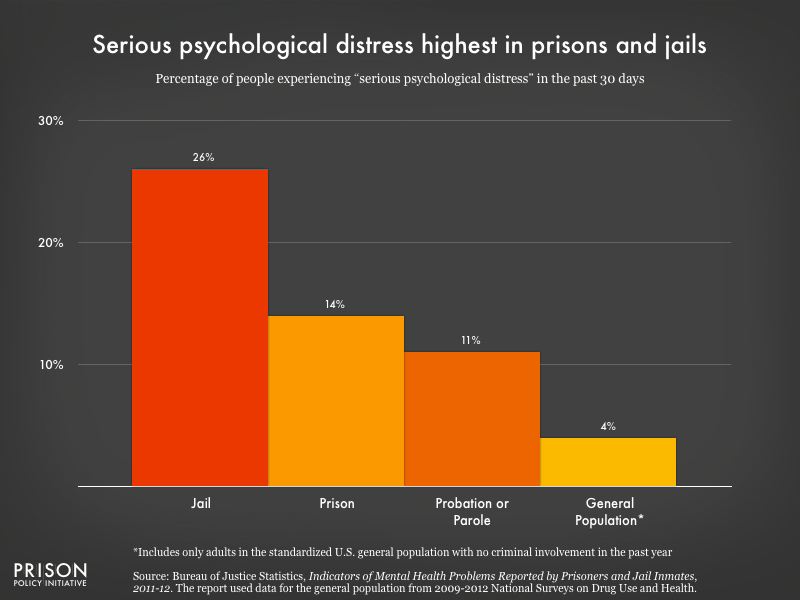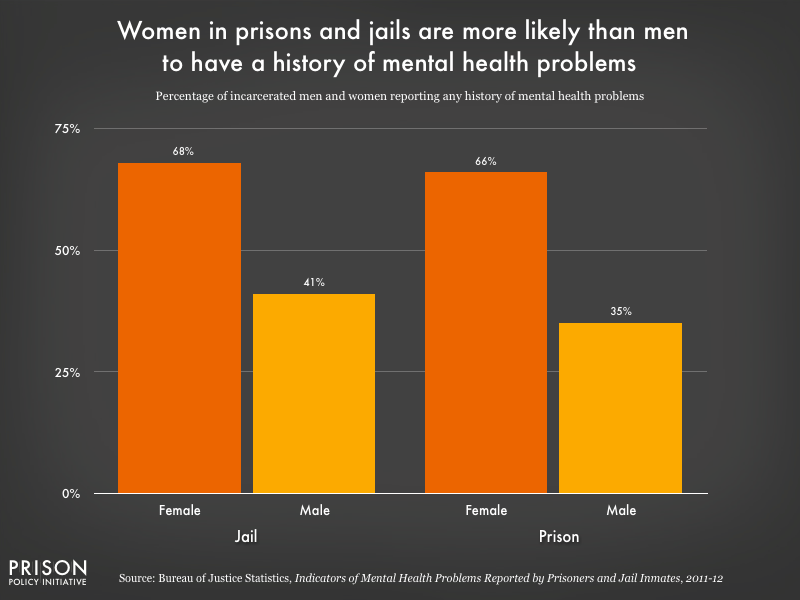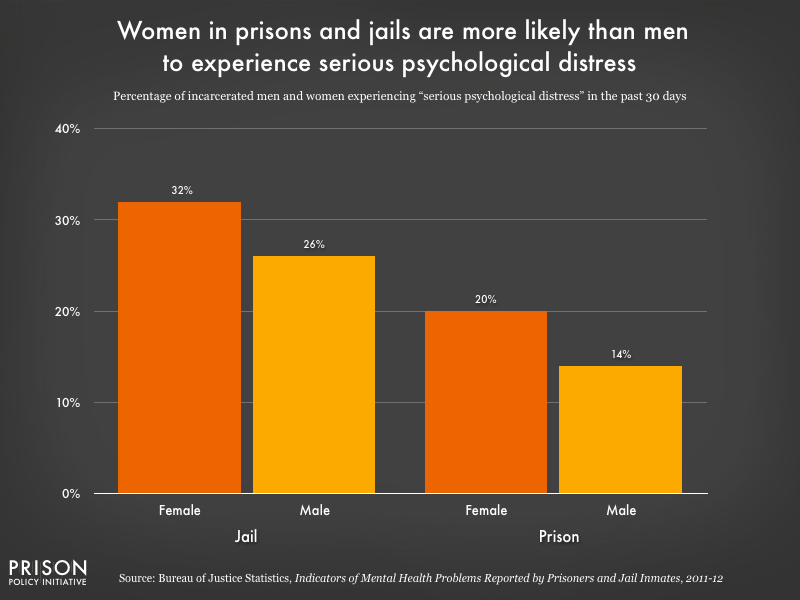New government report points to continuing mental health crisis in prisons and jails
U.S. prisons and jails are filled with people who have a current or past mental health problem, and facilities are still not meeting the demand for treatment.
by Wendy Sawyer, June 22, 2017
Today, a new Bureau of Justice Statistics report offers another grim view of mental health problems in America’s prisons and jails. Indicators of Mental Health Problems Reported by Prisoners and Jail Inmates 2011-12 is the first government update on the mental health of incarcerated populations since 2006. BJS has made some changes to its data collection, making comparisons to earlier reports difficult,1 but the takeaway is the same, ten years later: U.S. prisons and jails are filled with people who have a current or past mental health problem, and facilities are still not meeting the demand for treatment.
Half of people incarcerated in prisons and two-thirds of people in jails had either current “serious psychological distress”2 or a history of mental health problems. Yet only about a third of those reporting serious psychological distress were currently receiving treatment, and only a slightly greater share of people with a history of mental health problems was currently being treated. So while correctional facilities are warehousing people with mental health problems, they lack the capacity to adequately meet the needs of those in their care.
 1 in 4 people incarcerated in jails reported experiences that met the threshold for serious psychological distress. This makes people in jail six times more likely to experience serious psychological distress than people with no criminal justice involvement in the past year.
1 in 4 people incarcerated in jails reported experiences that met the threshold for serious psychological distress. This makes people in jail six times more likely to experience serious psychological distress than people with no criminal justice involvement in the past year.
People in prisons and jails experience serious psychological distress at much greater rates than the general public. This difference is especially pronounced among jail inmates – and especially in the first 30 days of incarceration – which is consistent with other reports of mental illness prevalence and the danger of even short stays in local jails. It’s unclear whether the high rates of psychological distress in jails is due to the stressful experience of incarceration or is a result of jailing people in crisis. But these statistics underscore the need to divert people at risk away from jail and connect them to more appropriate services in the community. Policymakers in some places seem to be catching on, but as this report reminds us, the need for more widespread reforms is urgent.
Women in jails, in particular, report high rates of mental health problems compared to men. The findings from this report are consistent with the 2006 report and others that find incarcerated women are more likely than men to have a history of mental health problems. But the new measure of serious psychological distress shows that women are also more likely to report current mental health problems – especially in jails, where as many as 1 in 3 women experiences serious psychological distress.
 Consistent with previous reports, female respondents in prisons and jails reported a history of mental health problems more frequently than male respondents.
Consistent with previous reports, female respondents in prisons and jails reported a history of mental health problems more frequently than male respondents.
 1 in 3 female respondents in jails reported experiencing symptoms of serious psychological distress – more than twice the rate of men in prisons.
1 in 3 female respondents in jails reported experiencing symptoms of serious psychological distress – more than twice the rate of men in prisons.
A final noteworthy finding from the new BJS report is the danger to others posed by people struggling with mental health problems. In prisons, people experiencing serious psychological distress are three times more likely to be written up for physical or verbal assault of correctional officers, staff, or other incarcerated people, compared to those without any mental health problems. In jails, people experiencing serious psychological distress are about 2.5 times more likely to assault others.
Again, we are reminded that appropriate treatment of health problems is essential for the health, safety, and well-being of not only affected individuals, but everyone around them, both while incarcerated and upon their return to the community.
Footnotes
- The new report is based on data from the 2011-2012 National Inmate Survey, and includes two mental health indicators: current “serious psychological distress” and any history of a mental health problem. The new measure of serious psychological distress (see footnote 2) gives a clearer picture of current mental health than the 2006 report, which asked about symptoms over the past year. Conversely, the measure of mental health history is broader than the one used in 2006; it asks respondents whether a mental health professional has ever told them they had a mental or emotional condition instead of limiting responses to just the past year. ↩
- “Serious psychological distress” was measured using the Kessler 6 scale, a tool used to screen for serious mental illness among adults. It asks how frequently in the past 30 days the respondent felt: nervous, hopeless, restless or fidgety, so depressed nothing could cheer them up, everything was an effort, and worthless. ↩




My husband has 3 Axis I diagnoses; he is an adult survivor of severe childhood abuse. Even though his diagnoses were made available to his attorneys, it was never discussed in court. Due to his mental health issues, he does have a criminal history, but has never been a violent offender; he didn’t know he was mentally ill until 2014. Most courts are not willing to acknowledge people as mentally ill because it upsets their paradigm of those accused being ‘bad’ and those who judge them as being ‘good’.
To date, my husband has lost 3 years of therapy in addition to the harm incarceration does to individuals. Our family has suffered because of a calloused, biased system; my child and myself were sentenced without having committed a crime. Where was our day in court?
Even when we know of abusive behaviors of staff against those incarcerated, we are threatened into silence for fear of retaliation against our loved ones. Elected officials care only about themselves…incarceration in our nation is only for the poor.